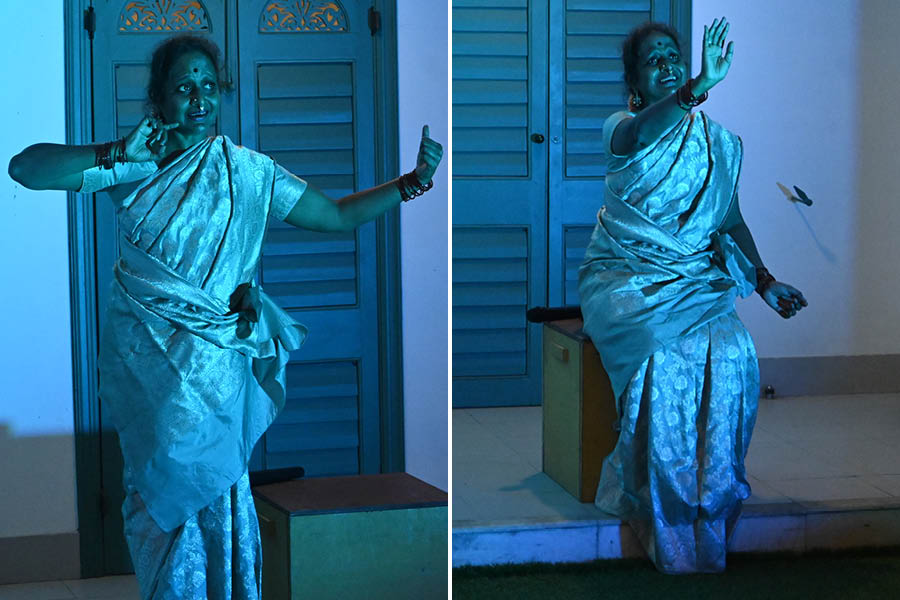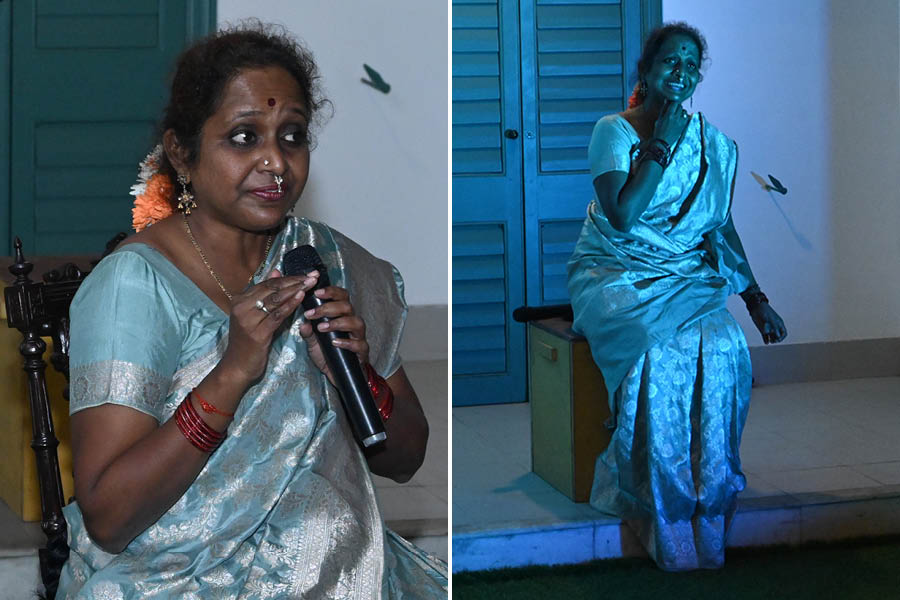With a nip in the air greeting a gathering of the city’s dance-curious, Yashoda Thakore, scholar and practitioner of Kuchipudi and devadasi nrityam, took the stage on November 13 at the Glenburn Penthouse. For her performance, which was interspersed with annotations shedding light on the form’s origins and reception, Thakore presented a padam composed and practised by the Kalavantulu community of Andhra Pradesh, depicting the heroine’s anxiety over losing her lover, Krishna. The heroine implores him not to wander, resolving in her longing to tie him to her person with her long, luscious tresses. “That’s why I have braided my hair this way today,” remarked Thakore, in front of the audience gathered for ‘Kalavantulu Conversations’, presented by Glenburn Culture Club, with My Kolkata as digital partner.
‘Your dance is built on another person’s life’

Thakore during her performance Amit Pramanik
The erotic charge of the padam informed its aesthetic character and gestural grammar, situating Thakore’s lecture-demonstration within the contexts, histories and politics of devadasi nrityam, which she went on to discuss at length, after her performance, with Paromita Chakravarty of Jadavpur University’s department of English. The evening was co-hosted by Pickle Factory Dance Foundation, as part of their Artist Diaries series for the season, with a delectable platter from the Glenburn menu and a selection from Fratelli Wines to round things off in style.
“Your dance is built on another person’s life,” said Thakore, hinting at the complex trajectories through which the Indian classical arts have reached us, sometimes predicated on violent histories of marginalisation, appropriation and disenfranchisement. Devadasi communities, spread across the south, had been practising their art with patronage from temples and zamindars across generations, in ways that conferred a certain agency upon the woman performer. As Thakore pointed out, devadasi artistes conducted and steered the performance, with the men of their family on the instruments. They were the custodians, if not owners, of land, property, jewellery — powerful performers in charge of an artform.
But the ideological bequest of imperial rule and the rise of a new nationalist agenda brought tough times for these performers. Chakravarty, in conversation with Thakore, noted that a certain collusion between nationalist and colonialist patriarchies yielded an organised inclination towards marginalising the sexual content of many performing arts traditions, effectively sanitising indigenous forms to produce ‘culture’ for the middle classes in their drawing rooms. This, Chakravarty observed, was noticeable in the story of jhumur dance in colonial Kolkata, as also in the better-known histories of dance forms like Kathak, where the courtesan grew to be a maligned, disempowered figure.
Thakore held that the seeds for this drive towards sanitising culture lay in our own deeply fractured caste society, which the British Raj codified damningly into letter. With the passing of the Madras Devadasis (Prevention of Dedication) Act, popularly known as the Devadasi Abolition Act, in 1947, these performers were shorn of their right to perform, and “shamed into not dancing”, noted Thakore. Their labour and craft as performers having been completely invisibilised, devadasis were either forced into prostitution, vulnerable to abuse from priests and the police alike, or obligated to marry, as their single-woman status posed a threat to their families’ precarious position in the respectability matrix. The devadasi, who was once the breadwinner, now faced a life of privation and scarcity. Thakore recounted the heart-wrenching story of a woman who smoked beedis by turning the butt inwards to kill her hunger with the smoke, only to die of stomach cancer.
‘Suddenly, you were supposed to dance for moksha, not money’

Thakore in conversation with Paromita Chakravarty Amit Pramanik
Thakore spoke poignantly on the ramifications of the Abolition Act for devadasi communities — while some women mourned the loss of their art, others strove to distance themselves from it in shame, in ways that fractured families and relationships. “A law is a law but what goes on in each heart when such a law is passed is a different matter,” she said. Once the devadasis were removed from public life, their art was planted on ‘respectable’ bodies: “They said: “Woman, you go — we will take the art.”
Upper-caste men adopted and hegemonised these dance forms, erasing their origins, looking down upon their economics, and situating them within ‘classical’ canons. “Suddenly, you were supposed to dance for moksha, not money,” Thakore joked, before adding: “Dance doesn’t come from the Natyashastra. It comes from bodies, from pain.”
What made the devadasi’s repertoire unique was its capacity and willingness to respond to context, as opposed to a stultification in tradition. The performer would sometimes look a member of the audience straight in the eye, addressing them as the lover — the power of such a gaze produced an aesthetic encounter that actively engaged the viewer, yielding the kind of intimacy that invests the experience of art with meaning and charge. As more and more students seek to learn a padam from her, Thakore asks them whether they are open or present enough to depict the “rawness of the padam’s sexual content”.
Among those present in the audience at Glenburn was Urmimala Sarkar Munsi of Jawaharlal Nehru University, who recounted her experience of meeting Thakore recently at a national seminar with all the luminaries of the dance world in attendance, where the panel on bharatanatyam featured not a single devadasi and mostly men! On being asked about the culture of silence pervading major classical arts institutions today, Thakore said, “My first instinct was to go back to Hyderabad when I saw what was happening, but I knew I needed to be there (at the seminar in Delhi), because there is no other way the devadasi voice will ever be represented.”

